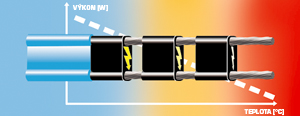Operation principle
The auto-regulating heating cable consists of a semi-conductor polymeric core, which is extruded between two parallel busbars. A polymeric insulation is then extruded over this core. Furthermore, the cable can be fitted with a metallic braiding or a fluorinepolymer or thermoplastic outer jacket.
The polymeric molecules with carbon particles conduct electric current through the feeding copper conductors. With increasing temperature the structure of the conductive material changes – carbon particles recede and this way increase the resistance against electric current. The heating output of the cable decreases. On the other hand, at low temperatures, the way for electric current is created and the output increases. Auto-regulating heating cables change their output according to the ambient temperature and supply just as much heat as is needed individually at any point of the length. Their length can be random and is only limited by the maximum current passing through the feed conductors.

Auto-regulating heating cables cannot overheat or burn out, therefore they may be used without thermostats and regulators. It is possible to shorten the cables during installation without calculating exact lengths. Accessories specified for individual types of cables are used for the installation.
Operation principle, cable section
Auto-regulating heating cables of each series are produced in several modifications. The principle of their marking is following:
FSx basic version of the heating cable
FSx/T heating cable with a tin-plated copper braiding, serving as a mechanical protection and grounding
FSx/I heating cable with a stainless steel braiding, serving as a mechanical protection and grounding with an increased chemical resistance
FSx/TP heating cable with a tin-plated copper braiding and an outer thermoplastic jacket, which provides a mechanical and chemical protection against water-based compounds
FSx/TF heating cable with a tin-plated copper braiding and an outer fluorinepolymer jacket, which provides a mechanical and chemical protection against hydrocarbon-based compounds
In each series, there are several versions available with different nominal outputs.
Example of a heating cable marking:
FST/TF 30 – auto-regulating heating cable for low temperatures designated primarily for industrial applications, with a tin-plated copper braiding and an outer fluorinepolymer jacket. Heating output is 30W/m at +10°C.
Standard supply voltage is 230 V, even 110 V (120 V) after an agreement.




